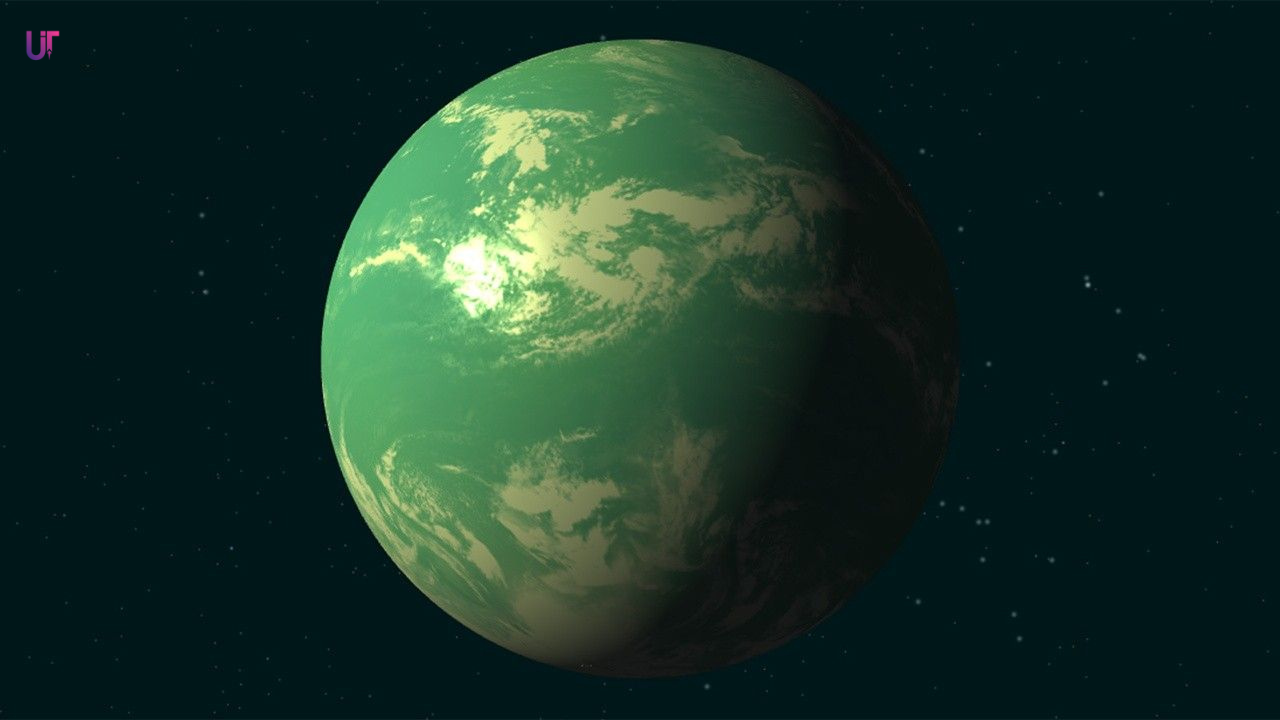Category: Exoplanets | Habitable Zone Worlds | Discovered by NASA’s Kepler Mission
The Planet That Opened a New Era
In 2011, astronomers using NASA’s Kepler Space Telescope announced a quiet revolution. Amid the countless stars the telescope was monitoring, one faint, Sun-like star showed a rhythmic dimming — the telltale sign of a planet passing in front of it.
That world was Kepler-22b, orbiting comfortably within its star’s habitable zone, where liquid water could, in theory, exist. For the first time, humanity had evidence of a planet similar in temperature to Earth, circling a star similar to our Sun.
It was more than a discovery; it was a confirmation of possibility.
The Planetary Profile
- Name: Kepler-22b
- Type: Super-Earth / Mini-Neptune (possibly oceanic)
- Distance from Earth: ~620 light-years
- Radius: ~2.4 × Earth
- Mass: Estimated 6–10 × Earth
- Star: Kepler-22 — a G-type (Sun-like) star
- Orbital Period: 289.9 days
- Orbital Distance: 0.85 AU (85% of Earth–Sun distance)
- Discovery: December 2011 by NASA’s Kepler
The host star, Kepler-22, shines with about 25% less luminosity than our Sun. Yet, because Kepler-22b orbits slightly closer, it receives nearly the same amount of stellar warmth Earth does.
Its orbit — roughly 290 days long — makes its “year” strikingly familiar to ours, a poetic coincidence that added to its early excitement.
What We Think Kepler-22b Is
At 2.4 times Earth’s radius, Kepler-22b sits in a curious category between rocky and gaseous worlds. Astronomers call these “super-Earths” or “mini-Neptunes,” planets that may possess thick atmospheres or vast global oceans.
If its surface is rocky, it could be a larger version of Earth, perhaps wrapped in clouds and seas.
If it’s more gaseous, it might resemble a smaller Neptune, with dense air, crushing pressures, and deep layers of fluid hydrogen above a solid core.
Because its mass remains uncertain, both pictures are possible. But its position in the habitable zone keeps hope alive for something extraordinary — perhaps an “ocean world”, where sunlight filters through endless blue waters under a sky tinted gold by its dimmer sun.
How We Found It
The Kepler Telescope was designed to stare at over 150,000 stars simultaneously, measuring their brightness every few minutes. Each time a planet passed in front of its star, Kepler recorded a tiny dip in light.
For Kepler-22b, that dip repeated every 289.9 days, three times in a row — enough to confirm its existence.
Follow-up observations with ground-based telescopes ruled out false positives, making Kepler-22b one of the first truly confirmed habitable-zone exoplanets orbiting a Sun-like star.
☀️ A Familiar Warmth, a Strange Sky
If you could stand on Kepler-22b (assuming a solid surface), your sky would appear dimmer and softer than Earth’s — the sunlight a little golden-green.
Your “Sun” would look slightly smaller, but warmth would feel similar, though filtered through a thicker atmosphere. Days might last longer, winds stronger. And if it has oceans, they might stretch endlessly, their horizons curving more dramatically due to the planet’s size.
Because of its mass and proximity to the star, Kepler-22b might be tidally stabilized, rotating slowly — perhaps with gentle weather and fewer extremes between day and night. See Tidal Locking
Why Scientists Are Excited
Kepler-22b was the first confirmed planet to lie squarely in the habitable zone of a Sun-like star. Before this, most discovered exoplanets were giant gas worlds orbiting too close or too far from their stars.
Its discovery proved that Earth-like conditions are not unique — that stars like our Sun can host planets with Earth-like temperatures.
Even if Kepler-22b turns out to be too large or gaseous for life as we know it, its existence reshaped the search itself. It became the benchmark for identifying the next generation of “second Earths.”
Future telescopes like JWST and PLATO could study its light more closely to detect atmospheric gases such as carbon dioxide, water vapor, or oxygen — the fingerprints of a living, breathing world.
A Doorway to the Possible
Kepler-22b may never host human footsteps or alien forests, but it cracked open the cosmic door we’d been knocking on for centuries.
It told us that somewhere, among billions of stars, Earth’s siblings exist — not just in science fiction, but in data, light, and mathematics.
For humanity, it wasn’t merely a discovery of another world — it was a discovery of hope made measurable.
✦ UTOPEDIA NOTES
“Kepler-22b taught us something subtle: that ‘Earth-like’ is not just about oceans and air — it’s about possibility. It was our first glimpse that the ordinary warmth of sunlight may fall on countless other worlds.”
Planetary Legacy
Kepler-22b remains the prototype for exoplanetary habitability.
Every discovery since — from TOI-700 d to K2-18 b — traces its scientific lineage back to this quiet blue dot orbiting a distant Sun.
It was the first world that made us say not just there are planets out there, but there are Earths out there.


